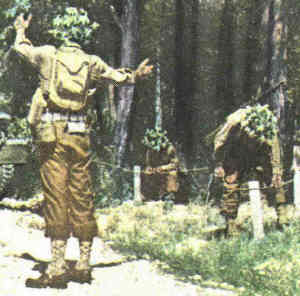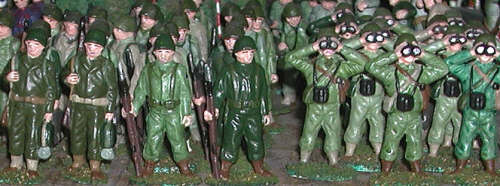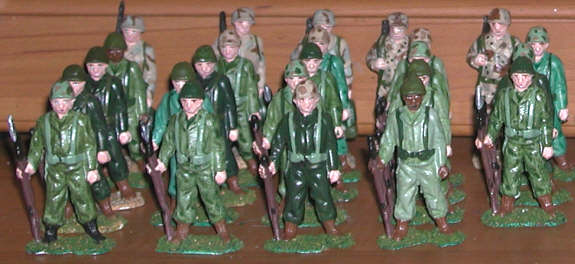
Copyright 2008 All Rights Reserved
{1}
The Classic G.I.
.
The soldier to our right is a classic infantryman from the start of World War II. He is a study in brown and khaki tan, with a little green thrown in for luck. That was how our nation entered the war.
By the war's end, a very different American soldier emerged. He was olive green from his helmet to the top of his boots. Green helmet, green fatigues and green field gear. Details may have changed, but from 1945 to 1980, green was the color of American soldiers and Marines.
I was part of the green army. Our uniforms were green. Our equipment was green. Our vehicles were green.
Of course, the green was not all that consistent. Fatigue uniforms ranged from olive drab to sage green. That was a matter of fading. The same happened to field gear. Instead of a field of green, it was shades of green.

As if the green colors were not enough:
|
Variety in green, from clothes to gear
|
|
More variety, this time on the march
|
|
And variety when sightseeing, G.I. style
|
All green and many variations, yet all are appropriate.
Here is a trick that makes good-looking figures:
Trick 1: base coat the uniforms a light sage, such as FolkArt Italian Sage. Let them dry a good 24 hours
Follow up with a wash of Teal Green, Forest Green or Olive Drab. I like to vary the washes, doing some in each color. When they dry, the effect varies. If you make a unit of men using various washes, you get good variations of green
Trick #2: base coat figures eucalyptus green (we use Delta Cermancoat's version). Let them dry 24 hours. Wash them with Teal Green to get a classic toy effect, not unlike some of the pre-War Elastolin figures. Of course, you can also use Forest Green and Olive Drab washes to vary your figures.
Trick #3: helmet covers. There are two types, Autumn and Summer. For Autumn, paint the entire helmet a light tan and let it dry. Follow with splotches of medium brown and a dark, slightly reddish brown. Cinnamon or Spice brown are good for the darker color.
For Summer, paint the helmet a pale green. Make sure it is not the same green as the basic uniform color, nor the webbed gear.. For instance, we use Sage or Wedgewood Green is the soldier's base color is Eucalyptus. We use Wedgewood or Eucalytpus if the uniform is Sage. Let the base color dry. Follow with splotches of medium brown and a darker green. I use forest green. Sometimes I will also use medium green splotches along with the darker green.
The Marines used camouflage helmet covers since World War II. Though the Army had a few at D-Day, it did not use camouflage covers widely until the early 1960s.
Trick #4 Vary your field gear. It fades, as it is often reissued several times. Field gear can go from dark olive to light sage. Even among men in the same unit, the variations can be extreme.
Troops wore brown boots up until the late 1950s. It was black boots after that.

: